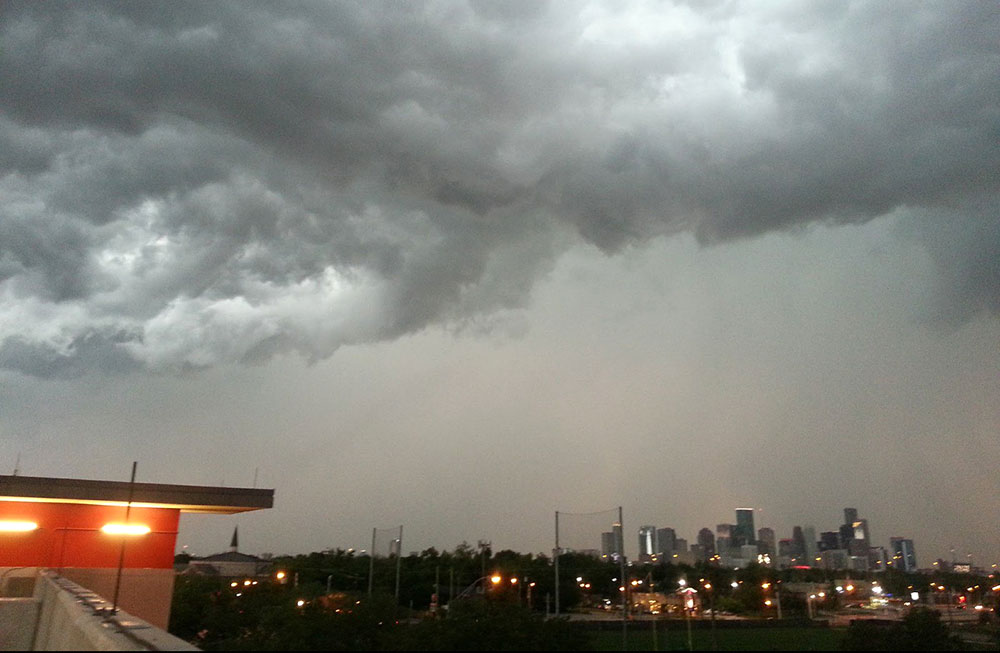Clouds, Aerosols, and Air Quality in the Coastal Urban Environment
DOE's TRACER campaign featured at American Geophysical Union (AGU) 2021 fall meeting
December 1, 2021
 enlarge
enlarge
Storm clouds over Houston, Texas. Does pollution make thunderstorms worse? Major field study launched this fall aims to find answers. (Courtesy of ARM)
MEDIA ADVISORY
The coastal urban environment presents unique challenges to our understanding of cloud, precipitation, and aerosol processes, regional air quality, local meteorological circulations, and the interactions among them. To better understand these processes and improve their representation in Earth system models, a multi-agency set of field campaigns are collecting a comprehensive set of state-of-the-art measurements in the Houston, Texas, region from September 2021 through September 2022. Meet some of the scientists involved in these studies and learn about their research at a Town Hall during the American Geophysical Union 2021 fall meeting.
WHAT: Hybrid in-person/online Town Hall event at the AGU 2021 fall meeting
WHEN: Monday, December 13, 2021, 11:15 a.m. – 12:15 p.m. U.S. Central Time (12:15 – 1:15 p.m. Eastern Time)
WHERE: In-person: New Orleans Ernest N. Morial Convention Center, 900 Convention Center Blvd, New Orleans, LA 70130 - Room 346-347 Online: Link will be available to registered reporters.
REGISTRATION REQUIRED: Press registration is free; up to five days required for verifying credentials
DETAILS: Houston, Texas, lies within a humid subtropical climate regime where onshore flow and copious sea-breeze-driven convection interacts with local urban and industrial emissions to degrade air quality. Multiple agencies (the U.S. Department of Energy, the National Science Foundation, NASA, and the Texas Commission on Environmental Quality — or TCEQ) have converged on the area to study these interactions. DOE’s TRacking Aerosol Convection interactions ExpeRiment (TRACER) focuses on aerosols (natural and industrial) and cloud lifecycle, and aerosol-convection interactions. NSF’s Experiment of Sea Breeze Convection, Aerosols, Precipitation and Environment (ESCAPE) campaign addresses the influences of the sea breeze and urban environment on convective clouds. And the NASA TRACER-Air Quality (AQ) campaign investigates the environmental influences on regional air quality. This Town Hall meeting will introduce each campaign, discuss some of the first observations, provide perspectives on the interagency cooperation, and offer opportunities for the science community to engage with follow-on research activities.
Speakers
Moderator: Michael P. Jensen, Brookhaven National Laboratory, Principal Investigator, TRACER
Presenters
- Laura Margaret Judd, NASA Langley Research Center
- Pavlos Kollias, Brookhaven National Laboratory and Stony Brook University
- Chongai Kuang, Brookhaven National Laboratory
- Greg M. McFarquhar, Cooperative Institute for Severe and High-Impact Weather Research and Operations
- John T. Sullivan, NASA Goddard Space Flight Center
TRACER is being carried out using instruments provided by the DOE Atmospheric Radiation Measurement (ARM) user facility with funding from the DOE Office of Science.
Media Contacts
Karen McNulty Walsh
Media and Communications Office
Brookhaven National Laboratory
kmcnulty@bnl.gov
(631) 344-8350
Rolanda Jundt
Public Information Officer
Atmospheric Radiation Measurement (ARM) User Facility
rolanda.jundt@pnnl.gov
(509) 308-3148
Brookhaven National Laboratory is supported by the Office of Science of the U.S. Department of Energy. The Office of Science is the single largest supporter of basic research in the physical sciences in the United States and is working to address some of the most pressing challenges of our time. For more information, visit science.energy.gov.
Follow @BrookhavenLab on Twitter or find us on Facebook.
2021-19267 | INT/EXT | Newsroom









